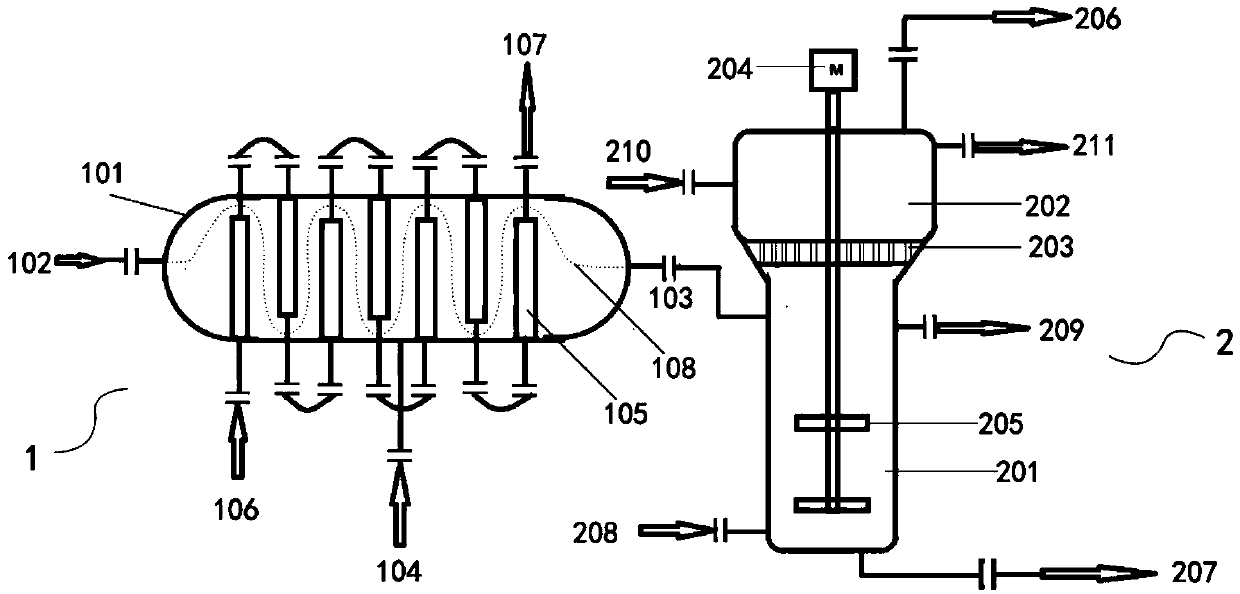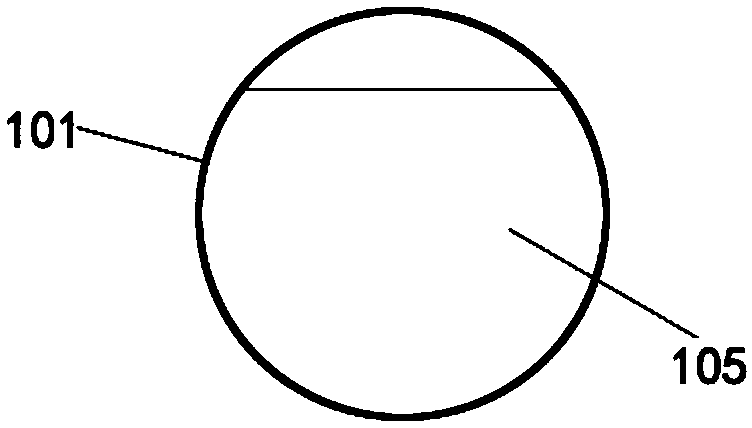Reaction device and method for preparing light hydrocarbon alternating copolymerization microsphere
A reaction device and alternating copolymerization technology, which are applied in chemical instruments and methods, microsphere preparation, chemical/physical/physical-chemical stationary reactors, etc., can solve the problems of undisclosed reaction devices and reaction methods, and achieve effective requirements. , Accurately control the reaction temperature and achieve the effect of removal
- Summary
- Abstract
- Description
- Claims
- Application Information
AI Technical Summary
Problems solved by technology
Method used
Image
Examples
Embodiment 1
[0089] use as Figure 1-2 The reaction apparatus shown for the preparation of light hydrocarbon alternating copolymerization microspheres was carried out. The reaction device includes a reactor 1, a gas-liquid separator 2 and a centrifuge (not shown in the figure) connected in sequence.
[0090] The reactor 1 includes a reactor shell 101 with a circular cross section, a hollow partition 105 arranged on the inner wall of the reactor shell 101, a first material inlet 102 arranged on the reactor shell 101 , the second material inlet 104 and the material outlet 103, and the material channel 108 from the first material inlet 102 to the material outlet 103; wherein, the hollow partitions 105 are staggered on the inner wall of the reactor shell 101 There are 7, so that the material channel 108 is formed inside the reactor shell 101, and the second material inlet 104 is located at 50% of the total length of the material channel 108; the reactor 1 passes through the material The outl...
Embodiment 2
[0100] Carry out according to the method for embodiment 1, difference is:
[0101] Using mixed carbon four B instead of mixed carbon four A, the mixed carbon four B composition (weight percentage) is: 1,3-butadiene 0.06%, trans-2-butene 12.67%, isobutane 37.09%, isobutene 19.48%, cis-2-butene 27.79%, 1-butene 1.02%, other 1.89%;
[0102] Organic reaction liquid is made up of 13.5kg mixed carbon four B, 20kg maleic anhydride, 4kg dibenzoyl peroxide and 100L isoamyl acetate;
[0103]The polymerization reaction pressure is 1MPa, the polymerization reaction temperature is 80°C, the first polymerization reaction time is 2.5h, and the second polymerization reaction time is 2.5h;
[0104] The centrifugation condition is 4000rpm, 20min;
[0105] Thus, solid copolymer particle powder B was prepared.
Embodiment 3
[0107] Carry out according to the method for embodiment 1, difference is:
[0108] Use mixed carbon four C instead of mixed carbon four A, mixed carbon four C composition (percentage by weight): trans 2-butene 30.83%, cis 2-butene 18.18%, n-butane 22.29%, 1-butene 9.52% , Isobutene 14.78%, Others 4.4%.
[0109] The organic reaction solution is composed of 15kg of mixed C4C, 20kg of maleic anhydride, 4.5kg of dibenzoyl peroxide and 100L of isoamyl acetate;
[0110] The polymerization reaction pressure is 1.5MPa, the polymerization reaction temperature is 80°C, the first polymerization reaction time is 1.5h, and the second polymerization reaction time is 3h;
[0111] Thus, solid copolymer particle powder C was prepared.
PUM
| Property | Measurement | Unit |
|---|---|---|
| particle diameter | aaaaa | aaaaa |
Abstract
Description
Claims
Application Information
 Login to View More
Login to View More - R&D
- Intellectual Property
- Life Sciences
- Materials
- Tech Scout
- Unparalleled Data Quality
- Higher Quality Content
- 60% Fewer Hallucinations
Browse by: Latest US Patents, China's latest patents, Technical Efficacy Thesaurus, Application Domain, Technology Topic, Popular Technical Reports.
© 2025 PatSnap. All rights reserved.Legal|Privacy policy|Modern Slavery Act Transparency Statement|Sitemap|About US| Contact US: help@patsnap.com



